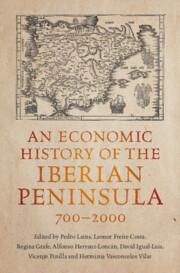Book contents
- An Economic History of the Iberian Peninsula, 700–2000
- An Economic History of the Iberian Peninsula, 700–2000
- Copyright page
- Contents
- Figures
- Tables
- Contributors
- Preface: By Way of Presentation
- Introduction
- Part I The Making of Iberia, 700–1500
- Part II Globalization and Enlightenment, 1500–1800
- Part III Industrialization and Catching Up, 1800–2000
- 18 Economic Growth and the Spatial Distribution of Income, 1800–2000
- 19 Population Growth, Composition and Educational Levels
- 20 Economic Policies and Institutions
- 21 Iberian Financial System, 1800–2000
- 22 Economic Growth and Structural Change in the Iberian Economies, 1800–2000
- 23 Living Standards in Iberia, 1800–2010
- 24 Iberian Globalization and Catching Up in the Poor South European Periphery, 1830–2010
- 25 The Iberian Economy in Comparative Perspective, 1800–2000
- References
- Index
23 - Living Standards in Iberia, 1800–2010
from Part III - Industrialization and Catching Up, 1800–2000
Published online by Cambridge University Press: 22 February 2024
- An Economic History of the Iberian Peninsula, 700–2000
- An Economic History of the Iberian Peninsula, 700–2000
- Copyright page
- Contents
- Figures
- Tables
- Contributors
- Preface: By Way of Presentation
- Introduction
- Part I The Making of Iberia, 700–1500
- Part II Globalization and Enlightenment, 1500–1800
- Part III Industrialization and Catching Up, 1800–2000
- 18 Economic Growth and the Spatial Distribution of Income, 1800–2000
- 19 Population Growth, Composition and Educational Levels
- 20 Economic Policies and Institutions
- 21 Iberian Financial System, 1800–2000
- 22 Economic Growth and Structural Change in the Iberian Economies, 1800–2000
- 23 Living Standards in Iberia, 1800–2010
- 24 Iberian Globalization and Catching Up in the Poor South European Periphery, 1830–2010
- 25 The Iberian Economy in Comparative Perspective, 1800–2000
- References
- Index
Summary
During the nineteenth century, Iberia entered the path towards modern economic growth. Although industrialization occurred later than in other Western European countries, economic progress ultimately led to an unprecedented improvement in the standards of living. This chapter aims to analyse the evolution of such advances and, when possible, compare Iberia with its Western European counterparts. In so doing, it presents several indicators capturing different dimensions of well-being, average income, consumption patterns, height, life expectancy, and a synthetic measure, the Human Development Index (HDI). Income distribution is examined by looking at alternative inequality indicators: Gini coefficient, the extraction ratio and top income shares. Based on this information the long-run evolution of economic inequality is assessed. All in all, the evidence presented shows that economic progress and well-being significantly improved in Iberia since mid-nineteenth century, although this happened at a slower pace than in Western Europe.
Keywords
- Type
- Chapter
- Information
- An Economic History of the Iberian Peninsula, 700–2000 , pp. 592 - 616Publisher: Cambridge University PressPrint publication year: 2024

